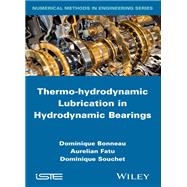This Series provides the necessary elements to the development and validation of numerical prediction models for hydrodynamic bearings. This book describes the thermo-hydrodynamic and the thermo-elasto-hydrodynamic lubrication. The algorithms are methodically detailed and each section is thoroughly illustrated.

Thermo-hydrodynamic Lubrication in Hydrodynamic Bearings
by Bonneau, Dominique; Fatu, Aurelian; Souchet, DominiqueBuy New
Rent Textbook
Rent Digital
Used Textbook
We're Sorry
Sold Out
How Marketplace Works:
- This item is offered by an independent seller and not shipped from our warehouse
- Item details like edition and cover design may differ from our description; see seller's comments before ordering.
- Sellers much confirm and ship within two business days; otherwise, the order will be cancelled and refunded.
- Marketplace purchases cannot be returned to eCampus.com. Contact the seller directly for inquiries; if no response within two days, contact customer service.
- Additional shipping costs apply to Marketplace purchases. Review shipping costs at checkout.
Summary
Author Biography
Aurelian FATU, Associate Professor, Prime Institute, University of Poitiers, France.
Dominique SOUCHET, Associate Professor, Prime Institute, University of Poitiers, France.
Table of Contents
PERFACE ix
NOMENCLATURE xi
CHAPTER 1. THERMO-HYDRODYNAMIC LUBRICATION 1
1.1. Global thermal balance 1
1.2. Energy equation for the lubricant film 4
1.2.1. Particular case of non-filled film zones 5
1.3. Fourier equation inside the solids 6
1.4. Boundary conditions 7
1.4.1. Supply ducts 7
1.4.2. External walls of solids 8
1.4.3. Surfaces at solid truncations 9
1.4.4. Interfaces between film and solids 9
1.4.5. Supply orifices and grooves 11
1.4.6. Axial extremities of the lubricant film 17
1.5. Bibliography 17
CHAPTER 2. THREE-DIMENSIONAL THERMO-HYDRODYNAMIC MODEL 19
2.1. Model description 19
2.2. Discretization of the film energy equation 20
2.2.1. Stationary case 20
2.2.2. Transient case 27
2.3. Discretization of Fourier equation in the solids 38
2.4. Assembly of discretized equations for the film and the solids 40
2.5. Numerical behavior of the THD finite element model 43
2.5.1. Definition of reference problems 43
2.5.2. Behavior for a stationary case 45
2.5.3. Behavior for a transient case 57
2.5.4. Behavior in the case of a variation in the axial direction of the film thickness 69
2.5.5. Evaluation of the global thermal method (GTM) 70
2.6. Bibliography 71
CHAPTER 3. SIMPLIFIED THERMO-HYDRODYNAMIC MODELS 73
3.1. Simplified THD model based on the Rhode and Li assumptions 73
3.1.1. Expression of the pressure and reduced Reynolds equation 73
3.1.2. Velocity components 75
3.1.3. Energy and Fourier equations 76
3.1.4. Discretization of equations 77
3.1.5. Evaluation of the method based on Rhode and Li assumptions 82
3.2. Simplified models for cyclic regimes 85
3.2.1. Model with the temperature averaged on the film thickness (ATM) 87
3.2.2. Model with a parabolic temperature profile across the film thickness (PTM) 95
3.3. Bibliography 101
CHAPTER 4. COMPUTING THE THERMOELASTIC DEPENDENCY MATRICES 103
4.1. Computing the thermoelastic dependency matrices to be used for the three-dimensional and Rhode and Li models 104
4.2. Computing the thermoelastic dependency matrices to be used for the simplified models 105
4.2.1. Equation setting for compliance matrices when the thermal boundary layer is modeled by a transfer coefficient 106
4.2.2. Equation setting for compliance matrices when the thermal boundary layer is modeled by a Fourier series 107
4.3. Bibliography 110
CHAPTER 5. GENERAL ALGORITHM AND SOFTWARE FOR SOLVING BEARING LUBRICATION PROBLEMS 111
5.1. Parameters and equations 111
5.1.1. The parameters that must be known before computing 111
5.1.2. The unknown parameters, objective of the computation 113
5.1.3. The equations to be solved 114
5.2. General algorithm 115
5.3. Solving finite element discretized EHD problem with the Newton–Raphson method 117
5.3.1. Constitutive equations for the EHD problem 117
5.3.2. Discretized equations for the EHD problem 119
5.3.3. Solving algorithm for the EHD problem 129
5.4. Techniques for reducing the computation time 131
5.4.1. Non-systematic evaluation of the Jacobian matrix 131
5.4.2. Decomposition of the hydrodynamic pressure 132
5.5. Mesh refinement 138
5.5.1. Principle of the refinement method 138
5.5.2. Computation of the local compliance matrix 140
5.5.3. Expression of the shell surface deformation 141
5.6. Architecture of software for bearing lubrication computation 143
5.7. An example of TEHD computation software: ACCEL 145
5.8. Bibliography 147
APPENDIX 149
INDEX 153
An electronic version of this book is available through VitalSource.
This book is viewable on PC, Mac, iPhone, iPad, iPod Touch, and most smartphones.
By purchasing, you will be able to view this book online, as well as download it, for the chosen number of days.
Digital License
You are licensing a digital product for a set duration. Durations are set forth in the product description, with "Lifetime" typically meaning five (5) years of online access and permanent download to a supported device. All licenses are non-transferable.
More details can be found here.
A downloadable version of this book is available through the eCampus Reader or compatible Adobe readers.
Applications are available on iOS, Android, PC, Mac, and Windows Mobile platforms.
Please view the compatibility matrix prior to purchase.
